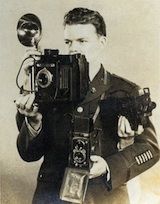- Forum
- General Discussion | Introductions | Off Topic Forum
- Photography General Discussion
- Question about white balance
Question about white balance
-
 Topic Author
Topic Author
- Summertime
- Has the Hang of it
-
- Canon t1i
- Followers: 10
- Posts: 74
-
Points:
0
Post #76583
however,
I have also read that, even for digital, to expose for 18% gray (like film). So which is it to get the best exposure?
If it IS gray, you should always have a gray card with you yes? And if you do, in the sun won't the gray card look lighter? What light situation is the gray card "correct"?
-

- Redhouse
- New Kid On The Block
-
- Canon mark iv
- Followers: 6
- Posts: 49
-
Points:
0
Post #76585
You are correct that blown highlights are mostly impossible to correct because they contain no data.
An 18% gray card is used to set preset white balance in your camera, when either auto white balance or one of the preset white balance settings in your camera can't get it right. One example would be indoors, with several different types of light(flourescent and incandescent) and sunlight coming in through skylights or a window.
-

- Rob pix4u2
- Photo Guru
- Nikon N90s & FE film & D90 and D90 digital bodies
- Followers: 196
- Posts: 4204
-
Points:
30
Post #76669
Remember to engage brain before putting mouth in gear
Rob Huelsman Sr.
My Facebook www.facebook.com/ImaginACTIONPhotography
-

- effron
- Newbie
- Followers: 1623
-
Points:
129640
-
 Topic Author
Topic Author
- Summertime
- Has the Hang of it
-
- Canon t1i
- Followers: 10
- Posts: 74
-
Points:
0
Post #76687
effron wrote: If I were to offer advice, i would likely say, "Watch the camera's meter, shoot raw, learn to post process and be done with it"......
Well you were able to offer advice.
-

- Henry Peach
- Apprentice
-
- I currently use a 5DII or Sony Nex-3 most of the time.
- Followers: 50
- Posts: 2925
-
Points:
16
Post #76811
Summertime wrote: I've read that for digital cameras you should expose for the highlights b/c shadows are easier to get detail from editing software, whereas if highlights are blown out, the detail is lost
This might work sometimes, but IMO it's bad advice to say use it all the time. Different scenes, lighting conditions, and desired outcomes may require different metering strategies. The best way is to fully understand the tools at your disposal.
With print film you expose for the shadows, because black means clear film. If there is no info there, it can't be recovered. Even if the highlights are very over-exposed it is theoretically possible to burn them in. So you only have to worry about losing detail at one end of the tonal scale. Slide film is positive so you do the opposite: expose for the highlights. White is clear film.
With digital you have this problem at both ends of the tonal scale. If you go too bright you lose highlight detail. If you go too dark you lose shadow detail. Digital requires that you assess both shadow and highlight exposure, and try to avoid problems at either end. Fortunately your camera has a wonderful, easy to use tool for this built in: the histogram.
In my experience it's much better for image quality to darken digital photos than to lighten them. There is a lot more information and steps in the tonal range at the highlight end than the shadow end. As you lighten shadows noise becomes more apparent, and posterization is possible.
Summertime wrote: I have also read that, even for digital, to expose for 18% gray (like film). So which is it to get the best exposure? If it IS gray, you should always have a gray card with you yes? And if you do, in the sun won't the gray card look lighter? What light situation is the gray card "correct"?
Photographic light meters are calibrated to middle gray or 18% gray (or at least that's the official word, there is some controversy). That means if you use the exposure level suggested by the meter whatever you are metering will come out middle gray. If you meter something that is middle gray in the same lighting as your subject then all the shadows and highlights should fall into place. If you meter highlights then the meter under-exposes, trying to make them gray. If you meter shadows the meter over-exposes, trying to make them gray.
Rather than carry a gray card with me, I have used my meter to figure out what the differences are in stops between the gray card and things that are commonly available. My camera bag is 1.5 stops darker than middle gray. My palm is 1 stop brighter than middle gray. A healthy, green grass lawn is approximately middle gray.
The gray card is middle gray in whatever light it's in, so you would meter off the gray card in the same lighting as your subject.
The problem is that the gray card only sets your midtones. The lighting situation can still have a greater dynamic range than the camera can capture. Dynamic range is the difference between light and dark. In a situation where the scene dynamic range is greater than your camera's dynamic range even if you have the midtones set you could still lose highlight and shadow detail. In these situations you need to either make a compromise on the exposure, change the scene lighting, or have a processing plan or technique in mind that can deal with it.
-

- TheNissanMan
- Moderator
-
- Canon 7D
- Followers: 34
- Posts: 826
-
Points:
135
Post #76851
Watch your histograms and you should be fine if you can shoot more than once, a tad more difficult when shooting wildlife but as said set the camera up on a healthy lawn if poss
-

- MLKstudios
- Banned
-
- D800 ;-)
- Followers: 72
- Posts: 4480
-
Points:
2
Post #77141
www.photographytalk.com/photography-arti...tipusing-a-gray-card
I consider learning about 18% reflectance in the meter a part of the learning process (and is why I insist my students use CWA metering and not Matrix), as that is what all meters are calibrated to (ignoring the controversy here). After you are familiar with that "tone", not the gray color, you can then adjust from it when needed. As HP has pointed out so well above.
As for setting WB you should have and use a WB tool (also called a gray card) for when you want perfect WB with a DSLR. Even if you don't it makes for a good starting point.
HTH,
Matthew
Note that most 18% tools aren't good WB tools. They are designed to have the right reflectance, but are not always color neutral, so the WB isn't quite right.
Matthew L Kees
MLK Studios Photography School
www.MLKstudios.com
[email protected]
"Every artist, was once an amateur"
-

- MLKstudios
- Banned
-
- D800 ;-)
- Followers: 72
- Posts: 4480
-
Points:
2
Post #77149
While a mountain that fits between the two edges is ideal, it isn't always possible (when the scene is beyond the cameras Dynamic Range), and this is where a knowledge of what areas can be clipped comes to play.
For example, if you shoot a portait indoors and there is a bright window behind your subject, a "bad" histogram "mountain" is expected. And the student needs to know what tones in the scene are being represented.
Matthew
Also, a "scene" doesn't have a Dynamic Range, it has contrast. It's the digital camera that has a DR limit.
Matthew L Kees
MLK Studios Photography School
www.MLKstudios.com
[email protected]
"Every artist, was once an amateur"
- Forum
- General Discussion | Introductions | Off Topic Forum
- Photography General Discussion
- Question about white balance
Latest Reviews
The Olympus Pen E-P7 is an affordable micro four thirds mirrorless camera with 4K video capabilities, a 20.3MP sensor, and 121 focus points, making it a solid entry-level camera for beginners.
The Panasonic G9 II is a 25.2-megapixel micro four thirds camera with numerous features that make it punch out of its weight class, like 779 AF points, 5.8K video, and weather sealing.
The Fujifilm XT5 is a 40MP mirrorless camera capable of 6.2K video at 30p. With those specs, it’s an ideal choice for photographers needing a camera to pull double duty for imaging and video.
The Canon EOS R100 is an entry-level mirrorless camera introduced in 2023. But just because it’s an entry-level camera doesn’t mean it’s a bare-bones camera. Find out why in this review!
Forum Top Posters
-
1Scotty 7 posts
-
2TCav 6 posts
-
3Ruby Grace 4 posts
-
4Street Shark 4 posts
-
5CharleyL 3 posts
-
6Roger Lang 3 posts
-
7Nefarious 3 posts
-
8Sassy Girl 2 posts
-
9Carter Gledhill 2 posts
-
10Garbo 2 posts
Latest Articles
The Olympus Pen E-P7 is an affordable micro four thirds mirrorless camera with 4K video capabilities, a 20.3MP sensor, and 121 focus points, making it a solid entry-level camera for beginners.
Starting a photography business is one thing; sustaining your business over a long period of time is another. Use the tips in this professional photography guide to build something with longevity!
The Panasonic G9 II is a 25.2-megapixel micro four thirds camera with numerous features that make it punch out of its weight class, like 779 AF points, 5.8K video, and weather sealing.
Cinematic photography is an interesting genre that combines photographic and videographic skills along with effective storytelling techniques. The result? Highly impactful images!
Newborn photography requires skill, the right gear, and a lot of patience. This beginner’s guide discusses critical topics that will help you be more prepared for before, during, and after the shoot.
To fill the frame means to expand the footprint of the subject in your shot. Get in close, zoom in, crop the image, or use other techniques to bring the subject to the forefront.
With these simple yet effective beginner photography tips, you can avoid some of the common mistakes beginners make and get improved results with your images.
Urban photography is a genre showcasing features in urban settings. You can photograph people, architecture, mass transit, and many other subjects. Learn how to do so in this guide!















